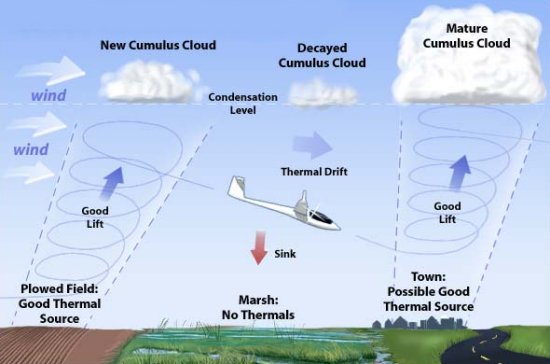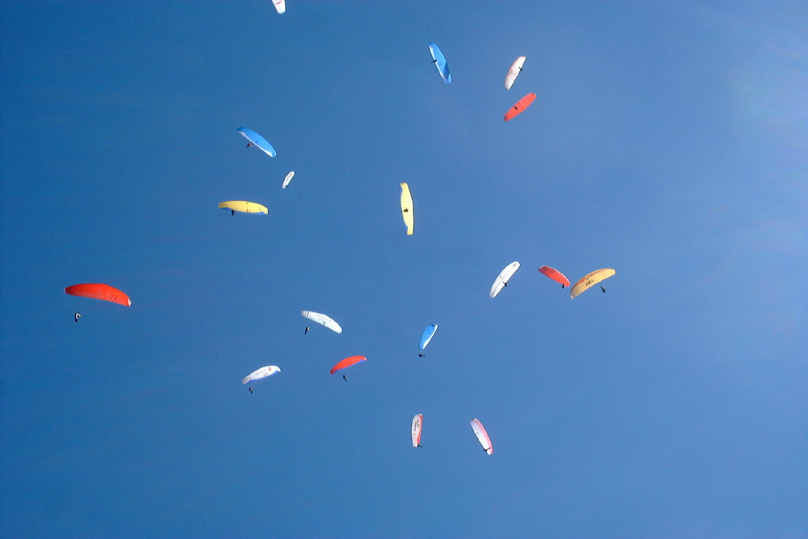












| 
| 
| 
| 
| 
| 
| 
| 
| 
| 
| 
|

|
by Will Gadd My favorite part of flying is undoubtedly thermalling; in fact, thermalling may be my favorite thing to do in life. There’s nothing like hooking a sharp-edged, positive ripper of a thermal and riding it upward for a couple of miles. My least favorite part of flying is also thermalling; those days when everyone else goes up flying straight and you hit the deck like a dropped park bench--repeatedly. On those days you’re glad you landed alone so no one else can hear you scream. The following is my latest “thermalling system.” I hope it helps you develop yours. Thermal Theory A little more thermal theory
is useful to understand how to fly them. I believe thermals close to
the ground are often quite small and relatively violent. As they rise
they tend to smooth out and expand. Pressure also tends to influence
thermal formation; high-pressure days tend to produce smaller, sharp-edged,
“punchy” thermals. Lower-pressure days can produce very strong
thermals obviously, but they tend to have mellower edges and be larger
in size. Coordinated Circles, not Swings OK, so you’re flying
along and your vario starts beeping with the good noises. What to do?
First, did your glider surge forward or fall back behind you just before
the beeps? If it went behind you then you’re probably dealing with
a “gust.” Wait and see if the beeping continues or goes back
to sink. If it’s a thermal and the beeping increases, turn. I don’t
worry too much about which direction; if one side of the glider is noticeably
more pressurized or higher above you, then lean meaningfully in that
direction and pull on the brake smoothly. How much pull ? Higher pressures
in your glider indicate a stronger thermal, meaning you can pull harder
you can. However, the most common mistake in thermalling is to pull
too aggressively on the inside brake. When you pull too hard on the
inside brake your body tends to swing to the outside of your turn in
a small wing-over. Then your body swings back under the glider, you
lose the turn and fly straight out of the thermal. Many pilots then
crank another wild-ass turn to try and get back into the thermal; I
flew this way for about five years before getting it figured out. What
you want to do is fly in a “coordinated” banked turn. This
is like riding a bicycle; you and the bike are at the correct bank angle
for your speed and the sharpness of the turn. One of the most common
problems pilots have is maintaining a consistent circle while thermalling;
I expect you know what I mean… The correct technique is to start
a turn with a smooth, controlled lean and simultaneous progressive inside
brake application. The glider will bank up, your body will follow it,
and due to centrifugal force you will continue to stay outside the glider’s
circle and smoothly ride the thermal up. Jerking the brake instead of
applying smooth increasing pressure will just swing you to the outside
of the glider--then you’ll swing back under it, repeat. The glider
will also remain over your head in a true coordinated turn; if it falls
behind you, reduce brake. If it threatens to surge in front of you,
apply a quick correction while maintaining your lean and turn. Centering: The mental map OK, so your vario is beeping
like mad; how long do you wait before turning? If the day’s thermals
are small and you’re low, start turning immediately after you’re
sure you’ve hit something (not just a gust). Rules of thumb about
waiting two seconds etc. are meaningless in my experience. You’ve
found lift, initiate a smooth banked turn and see what happens. If you
climb really well for a quarter circle and then start sinking, open
your circle up a little bit in the direction you found the best lift
then tighten as the lift increases; notice the pressure in your wing
and how your butt feels in the seat, not just the vario beeping, these
are critical clues. Listen to the noise in your ears as well; with practice,
you can actually hear the different air flows as you fly through lift
or sink; if you can’t hear the air then get a new helmet. At some
point in your circle everything will add up to the best lift as defined
by your vario, wing pressure and lift under your butt. If you’re
flying a coordinated 360 then it’s relatively easy to develop a
mental map of where the best lift is in each 360; don’t worry about
the ground, but where you encounter the best lift within each circle.
Try to develop a “mental map” of what’s happening in
each 360. Circle Size and Bank Angle I find I thermal with 30-45
or more degrees of bank on days with small, strong thermals, 15 to 30
on lower pressure days and almost flat on days with light, wide thermals.
The extremes of bank angles come in dust devils (almost vertical) versus
flying straight and flat while climbing like mad under a big cloud;
somewhere between these two extremes is the correct angle for your thermal
on that day. Every glider responds differently to brake force and the
amount of lean; what works for one pilot on his glider usually has little
to nothing to do with yours. However, every glider will circle in a
coordinated manner, and the feeling is unmistakable once you get it.
What do to do when you lose the lift First, know if you’re
at the top of the thermal or not. If every thermal so far has ended
at 6,000 AGL and you’re at 5,700 then forget about it and go on
glide. But if you’re climbing well at 3,000 AGL and lose the thermal
then it’s time to go into search mode. If there’s any wind
at all, the thermal is probably either directly down or upwind of you.
The first thing to do is expand the size of your circle and pay attention
to your mental map. If you were climbing at +200 fpm and then start
sinking at -600 on the upwind portion of the 360, open the circle up
back downwind. If the sink improves to -400 and then -200, move it even
more downwind. If nothing good happens, try moving upwind; again, an
improvement in sink is as as relevant as finding more lift, work toward
the area of lesser sink. Also pay attention to your groundspeed; it
will generally increase as you follow the air flowing into a thermal,
but decrease if you’re bucking the wind flowing into a thermal
by flying away from it (remember that thermals, especially when low,
pull or entrain air into them). If I’m low on windy days I tend
to fall out the upwind edge of the thermal. If I’m high on a windy
day I tend to fall out the downwind edge of the thermal. I have no idea
why, but that’s how it works. More Clues for Better Thermalling If the outside of your wing
loses pressure suddenly and ruffles or takes a mild collapse, you’ve
just found a relative difference in lift. Perhaps you’re in +600
and your outside wing just hit some +50; you want to move your circle
away from the area you just took the turbulence in and toward the better
lift. If you’re thermalling in a gaggle and see someone take an
outside wing deflation ahead of you in the circle, then it’s probably
worth tightening your circle away from that area and then opening it
slightly to fly toward the better lift, tightening the circle as you
encounter better lift. Most pilots tend to fly the “pattern”
in a thermal rather than really watching the climb rates of the other
gliders; if everyone climbs better in one half of their circle than
the other, move your circle toward the better lift; you’ll climb
above the other gliders quite quickly using this tactic. If someone
is out-climbing you off to one side then move your circle to them; there’s
no heroism in climbing slowly by yourself. Will Gadd will be running XC clinics across the United States and Canada this summer; check gravsports.com for a schedule or contact him at gadd@gravsports.com if you’re interested! |
 Thermalling in Mexico at a PWC Meet Thermal Flying By Daniel Crespo Valdéz. (Published in the spanish magazine Parapente Vuelo Libre 2002)
Thermal
flying is a desire for every pilot. Thanks to this technique we will be able
to, literally, expand our horizons and begin to discover the true virtues
of free flying. Some pilots concern about the turbulences associated to this
kind of active flying; actually, we have to face the cost of this pleasure
-which in any case is that high. Thermal flying involves some instability
and continuous movements of the air, and it is precisely thanks to these movements
that we can climb up in the sky. We have to learn how to deal with them so
we can pilot to our benefit, and fun!
Turbulence
Strong, but silk-handed
-If you really want to train thermal flying (and become an ace!), fly the morning thermals and try to work out the first lifts, which are trickier. -If you are low, never give up on a zero -although it might seem poor to you. If you hang on it long enough you will probably catch the new, stronger thermal that will come up. -It is always better to fly fast, with some reserve of speed that you will be able to use at your convenience in a correction that may require agility. -To begin in the thermal flying use a simple, safe glider that absorbs the turbulence well. -Watch the ground. In thermal areas, better not scratch too near the ridge. -Start in a place where conditions are not too rough (not the 'most famous' place for thermal flying) but where you can find smooth thermals. Pay attention to the strongest hours of the day in the hot season (stay grounded) and hear trustable advice. -Take advantage of the smooth times of the day, before 12:30 and after 4pm. As you learn more and have better control in thermal conditions, you can gradually extend your flying hours. -Fly
a lot! |
